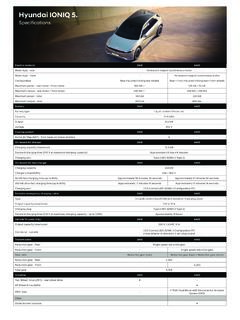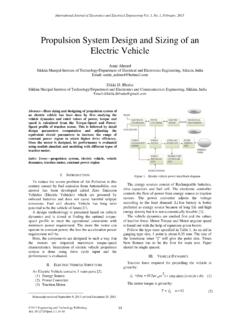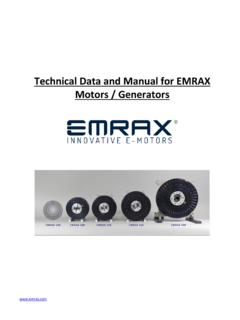Transcription of SiC MOSFET Benefits - STMicroelectronics
1 SiC MOSFET Benefits Jeff Fedison Sr. Applications Engineer Agenda 2. SiC MOSFETs Overview of EV/HEV Power Electronics EV traction Inverter Design Example Conclusion SiC MOSFET . A Real Revolution for high-voltage Power Switches Wide Bandgap Materials 4. Radical innovation for Power Electronics Si GaN 4H-SiC. Eg (eV) Band gap Vs (cm/s) Electron saturation velocity 1x107 2x107. r dielectric constant 10 Ec (V/cm) Critical electric field 3x105 k (W/cm K) thermal conductivity 5. Ec low on resistance Vs Higher switching frequency Lower switching losses Eg low leakage, high Tj k Operation > 200 C. Reduced Cooling Requirements Benefits of SiC MOSFETs 5. Key Benefits Extremely low Energy Losses and Ultra-Low RDS(on) especially at very high Tj Higher operating frequency for smaller and lighter systems Good Thermal Performance High operating temperature ( Tjmax = 200 C).
2 Reduced cooling requirements & heat-sink, Increased lifetime Easy to Drive Fully compatible with standard Gate Drivers Very fast and robust intrinsic body diode More compact Inverter High-Voltage DMOSFET Structure 6. RChannel RDrift RDS(on) is determined mainly by RDrift and to some extent RChannel. RDS(on) Entitlement for 650V DMOSFET 7. Silicon vs SiC. Silicon Drift layer SiC. ECritical ~ MV/cm dimensions ECritical ~ MV/cm for equal Area=300 units resistance Area=1 unit microns 43 microns Nd = 3x1016 cm-3. For equal drift layer resistance at Tj=25C: Nd = 5x1014 cm-3. 1. AREA: SiC = Silicon 300. 1. THICKNESS: SiC = Silicon 8. 1. CAPACITANCE: SiC = Silicon 44. THERMAL RESISTANCE: SiC = 12 Silicon SiC offers dramatic reduction in device footprint. MOSFET RDS(on) Figure of Merit at TJ=150C 8. RDS(on),max Die Area (mW cm2). 30x Rated Blocking Voltage (V).
3 RDS(on) Variation with Temperature 9. 1200V SiC MOSFET . Normalized RDS(on). 57% lower 33% lower SCT30N120. 0 25 50 75 100 125 150 175 200 225. C. ST (SiC) Nearest Comp. (SiC) Silicon MOSFET (900V). ST SiC MOSFET shows lowest Ron at high temperatures ST is the only supplier to guarantee max Tj as high as 200 C in plastic package SiC MOSFETs in Full Production 10. 1200V Series RDS(on) typical VDS Qg 25 C Id Package P/N. [V] (nC). [m ]. 52 65 122 HiP247 & Bare Die SCT50N120. 80 45 105 HiP247 & Bare Die SCT30N120. 1200. 169 20 45 HiP247 SCT20N120. 520 12 21 HiP247 SCT10N120. Key Full Production in Q2. Applications HiP-247TM H2 PAK HEV/EV. SMPS Solar OBC &. Industrial & Charging 2 and 7 leads traction & PFC Inverter station Drives Gate Driving Voltage = 20 V. HiP247TM Package: Tjmax=200 C. ST 650V 2nd Gen SiC MOSFET 11. SCTW100N65G2AG. RDS(on) (typ @25 C) : 20 mOhm RDS(on) (typ @200 C) : 23 mOhm Qg (typ) : 215 nC.
4 Package : HiP247TM. ST SiC MOSFET shows lowest Ron increase at high temperatures ST is the only supplier to guarantee max Tj as high as 200 C. Gate driving voltage = 20V. Full Maturity: Q2 2017 (Industrial Grade). Full Maturity: Q2 2017 (Automotive Grade). Why SiC MOSFET Allows Lowest 12. Conduction Losses 1 2 n 1 2 n . When n MOSFET are paralleled When n IGBTs are paralleled the the total RDS(on) must be divided by Vce(sat) doesn't decrease linearly, the n allowing ideally zero conduction minimum achievable on-state losses voltage drop is about 1V. The lowest possible conduction losses can be achieved only RDS(on). with MOSFETs Hard-Switched Power Losses 13. SiC MOSFET vs. Si IGBT. SiC MOSFET vs. trench gate field-stop IGBT. Parameters Von typ. (V) Von typ. (V) Eon ( J) Eoff ( J) Eoff Die size &. (Normalized) @ 25 C, 20A @ 150 C, 20A @ 20A, 800V @ 20A, 800V 25 C / 150 C.
5 Conditions 25 C / 150 C. 25 C / 150 C difference (%). SiC MOSFET 500 / 450* 350 / 400 +15% from 25 C to 150 C. IGBT 800 / 1300** 800/ 1900 +140% from 25 C to 150 C. * Including SiC intrinsic body diode Qrr ** Including the Si IGBT copack diode Qrr SiC MOSFET . Data measured on SiC MOSFET engineering samples;. SiC MOSFET device : SCT30N120, 1200V, 34A (@100 C), 80m , N-channel Si IGBT device: 25A(@100 C) 1200V ST trench gate field-stop IGBT (Tj-max=175 C). SiC switching power losses are considerably lower than the IGBT ones At high temperature, the gap between SiC and IGBT is insurmountable SiC die size compared to IGBT. SiC MOSFET is the optimal fit for High Power, High Frequency and High Temperature applications SiC MOSFET Driving Requirements 14. Driving a SiC MOSFET is almost as easy as driving a silicon MOSFET : Just need VGS = 20V to get the right RDS(on).
6 Adequate current capability to ensure high speed (2-3 A would be the best). Very simple and very mature standard gate drivers can be used ST TD350 + push-pull stage (to increase current capability) in production The new ST isolated GAPdriver available now A detailed Application Note focused on how to drive a SiC. MOSFET has been published on : AN 4671. SiC MOSFET Benefits 15. Switching losses are dramatically reduced even in hard-switching topologies . System cost reduction Unlike the IGBT, the MOSFET has no turn-on knee voltage giving low conduction losses across the entire load range The ONLY SiC alternative that offers intrinsic body diode with very low reverse recovery charge Minimal increase in RDS(on) with temperature allowing higher temperature operation with good efficiency Easy to drive use of conventional gate drivers ensures low component count Reliability Very good final Result (done @ 200 C!)
7 Overview of EV/HEV Power Electronics e-Vehicle Block Diagram Output Power: 4kW. 17. IGBT SiC MOSFET HEV/EV. 50kHz 200kHz EPS, ICE. cooling M. Aux LV inverters battery DC/DC. (12V or 24V) converter Cells Aircon balancing inverter M. DC/DC Silicon content converter HV battery El motor / pack generator Auxiliary AC (200V to 450V) Mechanical or HEV electro-mechanical inverter loads ECU traction Battery module inverter ICE HV Bus Batteries Hybrid drive (no EV) On-board DC/DC. unit (HDU). charger converter (optional). (ACinput) Fast charging (DC). Output Power: 200kW. IGBT SiC MOSFET Output Power: 50kW. Up to 20kHz Si MOSFET SiC MOSFET . Output Power: 20kW 50kHz 200kHz SiC Diode or SiC MOSFET depending on topology 50kHz 200kHz Main Inverter for HEV/EV 18. Usually 3-phase permanent magnet motors are used for traction Operating voltage from 48V to 800V. Bi-directional Feed the electric motor when driving the wheels Stream energy back on HV Bus when breaking the vehicle Nominal power ranging from 10kW (ICE assistance).
8 To 100kW (pure EV). Inverter stage permanent magnet M For bus up to 400V SiC MOS 650V. For bus in the range [400V-800V] SiC. MOS 1200V. Battery Charger for HEV/EV 19. PFC DC-DC. Stage Conv. 3 phase PFC Bidirectional Full bridge DC/DC Converter 480V. DC. Sensors & signals conditioning 6x Gate drivers 2x HB drivers 2x HB drivers Sensors and signal PFC and DC/DC Control unit(s) conditioning Single-phase architecture SiC MOS 650V. Three-phase architecture mainly SiC MOS 1200V. 80kW EV traction Inverter Power Loss Estimation: 650V SiC MOSFETs vs Existing Silicon IGBT-based Power Module Operating Conditions 21. Topology: Three phase inverter PWM Strategy: Bipolar Synchronous rectification (SiC version). DC-link voltage: 400 Vdc Current 480 Arms (peak) 230 Arms (nom). Switching frequency: 16kHz Vgs=+20V/-5V for SiC, Vge= 15V for IGBT Si IGBT requires Cos(phi): antiparallel Si diode, Modulation index (MI): 1 SiC MOSFET does not Cooling fluid temperature: 85.
9 RthJ-C(IGBT-die)= /W; RthJ-C(SiC- die)= /W. Tj 80%*Tjmax at any condition Switch (S1+D1) implementation 4 x 650V,200A IGBTs + 4 x 650V,200A Si diodes vs. 7 x 650V, 100A SiC MOSFETs SCTx100N65G2. Design Considerations 22. The devices were dimensioned in order to get a junction temperature equivalent to roughly 80% of the absolute maximum rating given in the datasheet at the peak power condition. The overall working conditions are: Peak-power condition 480 Arms, 10sec. Normal working condition up to 230 Arms. Power Loss at Peak Condition 23. * Typical power loss values (480 Arms,10sec). Loss Energy Si-IGBTs + Si-diodes Full-SiC SiC vs Si per Solution Solution switch (S1+D1). 400 mm (IGBT) +. Total chip-area 140 mm lower 200mm2 (diode). Conduction losses* (W) Turn-on losses* (W) > 4x lower Turn-off losses* (W) > 7x lower Diode's conduction losses*. Negligible (W).
10 Diode's Qrr losses* (W) Negligible (S1+D1) Total losses* (W) 723 435 40% lower Junction Temperature ( ) TJ ~ 80% Tjmax SiC MOSFET runs at higher junction temperature in spite of lower losses. This is due to the exceptional SiC RDSON x Area FOM. SiC Solution: Lower Losses, Higher Efficiency 24. fsw=16kHz, Operating phase current up to 230 Arms Inverter losses vs %load Inverter efficiency vs %load 75% lower loss * The simulated efficiency takes into account only the losses due to the switches and diodes forming the bridge inverter SiC shows much lower losses in the whole SiC offers 1% higher efficiency or more load range over the whole load range! Lower losses mean smaller cooling system and longer battery autonomy Remarks About Junction temperature 25. Operating phase current up to 230 Arms RthJ-C(IGBT-die)= /W;. RthJ-C(SiC-die)= /W. SiC solution is better than Silicon one in terms of reliability since SiC has lower (Tj-Tfluid) up to 100% load.














